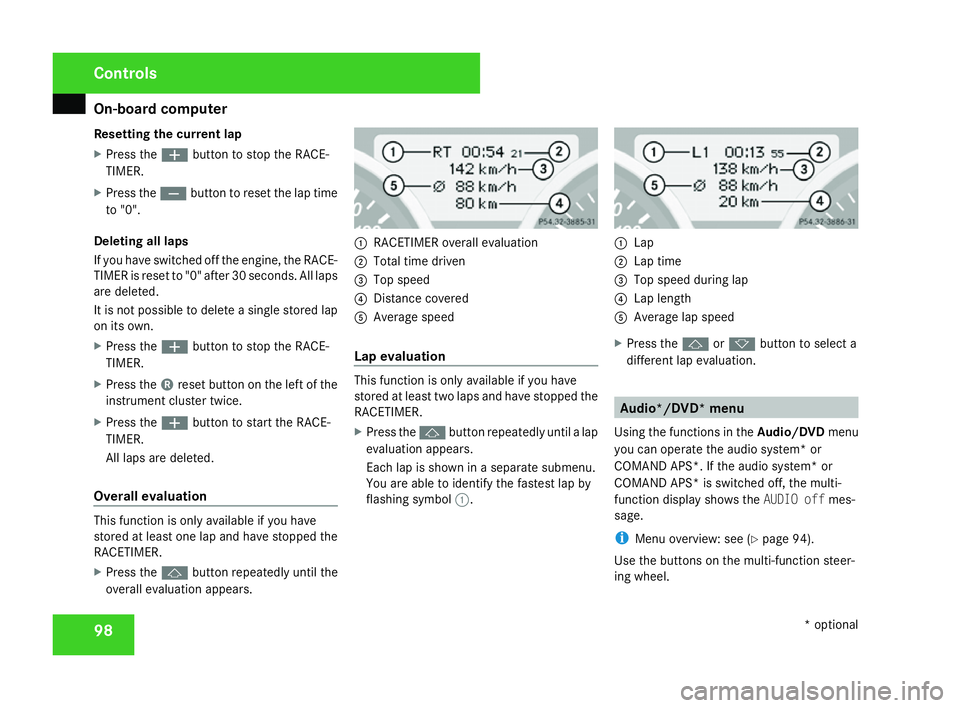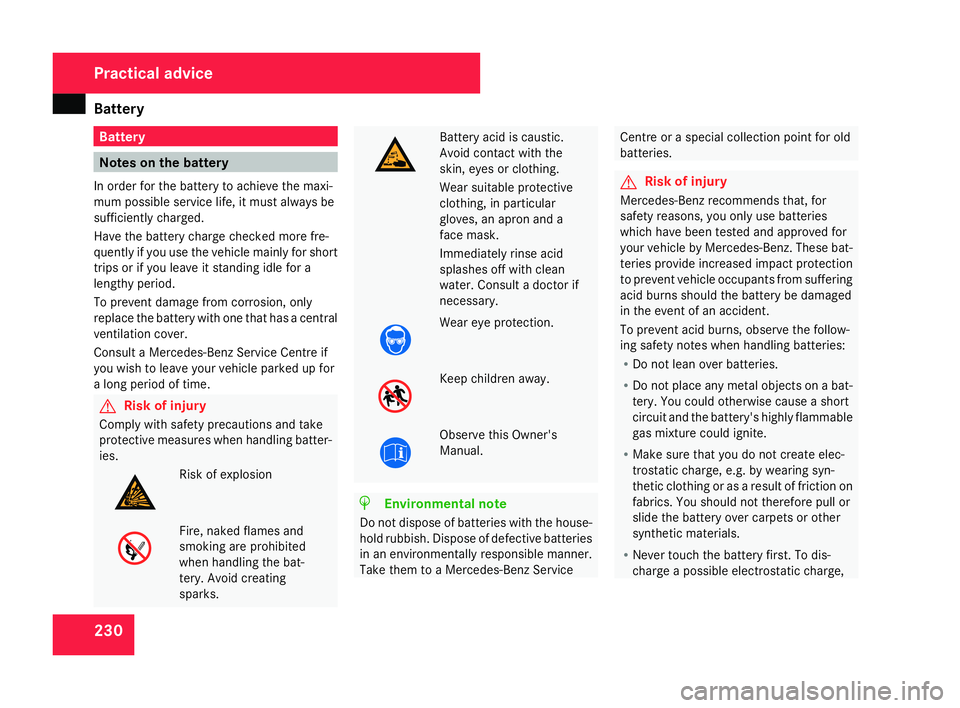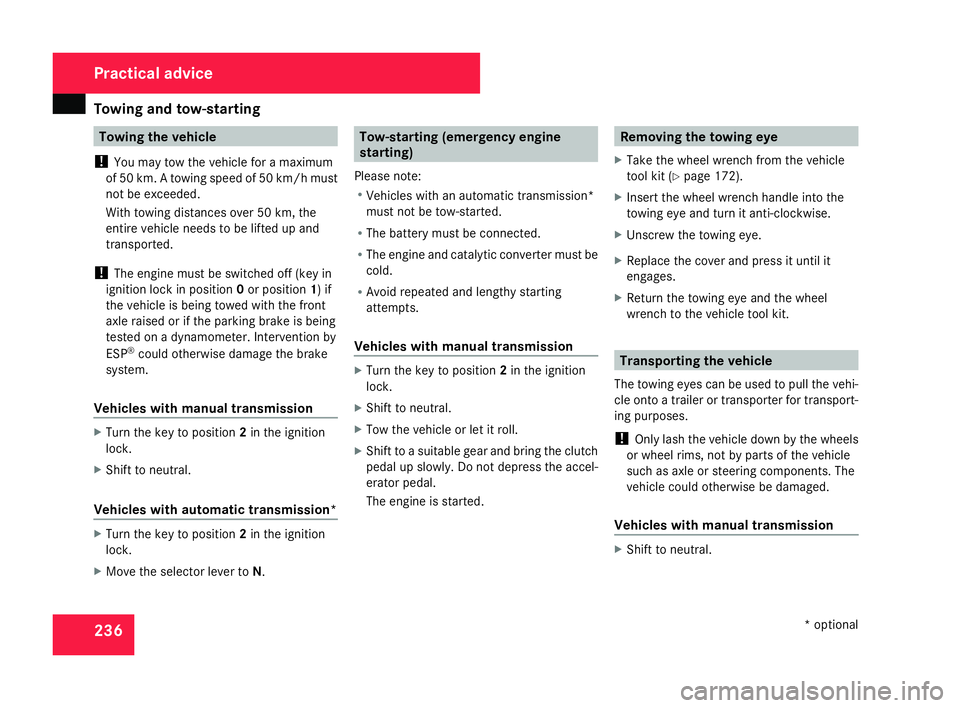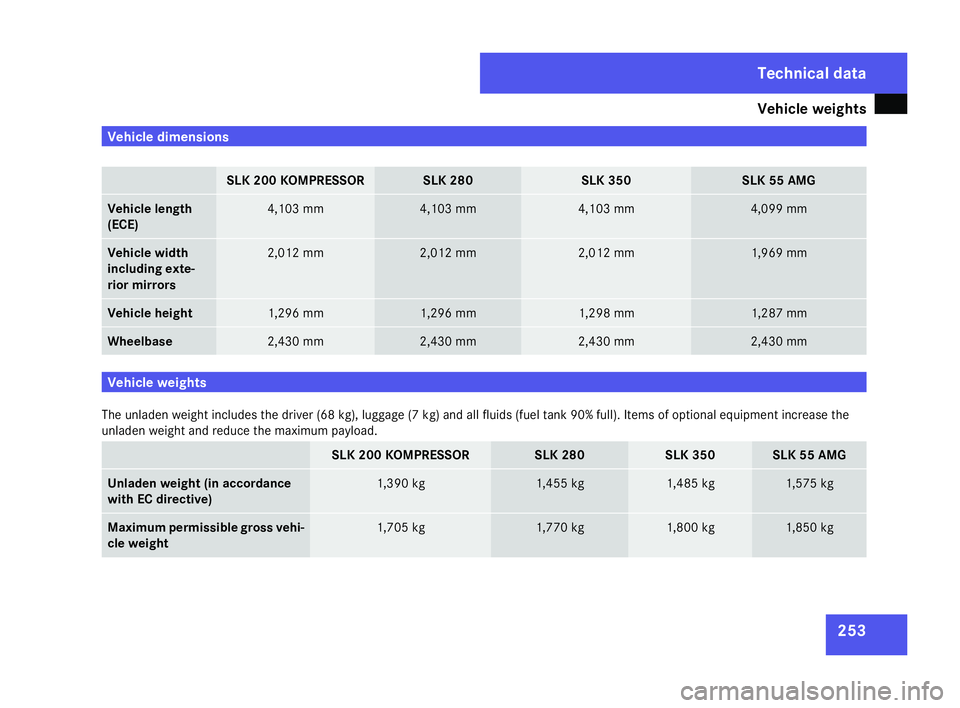2008 MERCEDES-BENZ SLK ROADSTER length
[x] Cancel search: lengthPage 101 of 273

On-board computer
98
Resetting the current lap
X
Press the æbutton to stop the RACE-
TIMER.
X Press the çbutton to reset the lap time
to "0".
Deleting all laps
If you have switched off the engine, the RACE-
TIMER is reset to "0" after 30 seconds. All laps
are deleted.
It is not possible to delete a single stored lap
on its own.
X Press the æbutton to stop the RACE-
TIMER.
X Press the 4reset button on the left of the
instrument cluster twice.
X Press the æbutton to start the RACE-
TIMER.
All laps are deleted.
Overall evaluation This function is only available if you have
stored at least one lap and have stopped the
RACETIMER.
X
Press the jbutton repeatedly until the
overall evaluation appears. 1
RACETIMER overall evaluation
2 Total time driven
3 Top speed
4 Distance covered
5 Average spee d
Lap evaluation This function is only available if you have
stored at least two laps and have stopped th
e
RACETIMER.
X Press the jbutton repeatedly until a lap
evaluation appears.
Each lap is shown in a separate submenu.
You are able to identify the fastest lap by
flashing symbol 1. 1
Lap
2 Lap time
3 Top speed during lap
4 Lap length
5 Average lap spee d
X Press the jork button to select a
different lap evaluation. Audio*/DVD* menu
Using the functions in the Audio/DVDmenu
you can operate the audio system* or
COMAND APS*. If the audio system* or
COMAND APS* is switched off, the multi-
function display shows the AUDIO offmes-
sage.
i Menu overview: see (Y page 94).
Use the buttons on the multi-function steer -
ing wheel. Controls
* optional
171_AKB; 3; 4, en-GB
vpfaff7,
2007-11-13T10:50:25+01:00 - Seite 98
Page 233 of 273

Battery
23
0 Battery
Notes on the battery
In order for the battery to achieve the maxi-
mum possible service life, it must always be
sufficiently charged.
Have the battery charge checked more fre-
quently if you use the vehicle mainly for short
trips or if you leave it standing idle for a
lengthy period.
To prevent damage from corrosion, only
replace the battery with one that has a central
ventilation cover.
Consult a Mercedes-Benz Service Centre if
you wish to leave your vehicle parked up for
a long period of time. G
Risk of injury
Comply with safety precautions and take
protective measures when handling batter-
ies. Risk of explosion
Fire, naked flames and
smoking are prohibited
when handling the bat-
tery. Avoid creating
sparks. Battery acid is caustic.
Avoid contact with the
skin, eyes or clothing
.
Wear suitable protective
clothing, in particular
gloves, an apron and a
face mask.
Immediately rinse acid
splashes off with clea n
water. Consult a doctor if
necessary. Wear eye protection
. Keep children away.
Observe this Owner's
Manual. H
Environmental not
e
Do not dispose of batteries with the house-
hold rubbish. Dispose of defective batteries
in an environmentally responsible manner.
Take them to a Mercedes-Benz Service Centre or a special collection point for ol
d
batteries. G
Risk of injury
Mercedes-Benz recommends that, for
safety reasons, you only use batteries
which have been tested and approved for
your vehicle by Mercedes-Benz. These bat-
teries provide increased impact protectio n
to prevent vehicle occupants from suffering
acid burns should the battery be damage d
in the event of an accident .
To prevent acid burns, observe the follow-
ing safety notes when handling batteries:
R Do not lean over batteries .
R Do not place any metal objects on a bat-
tery. You could otherwise cause a short
circuit and the battery's highly flammabl e
gas mixture could ignite.
R Make sure that you do not create elec-
trostatic charge, e.g. by wearing syn-
thetic clothing or as a result of friction on
fabrics. You should not therefore pull or
slide the battery over carpets or other
synthetic materials.
R Never touch the battery first. To dis-
charge a possible electrostatic charge, Practical advice
171_AKB; 3; 4, en-GB
vpfaff7,
2007-11-13T10:50:25+01:00 - Seite 230
Page 236 of 273

Battery
23
3
i
If the battery power supply has been inter-
rupted (e.g. if it has been reconnected), you
must carry out the following tasks:
R Set the time (Y page 104).
R Reset the function for folding the exterio r
mirrors in/out automatically* by folding
the mirrors out once (Y page 66). Jump-starting
If your vehicle's battery is discharged, the
engine can be jump-started from another
vehicle or from an external battery using jump
leads.
Observe the following points:
R Jump-starting may only be performed when
the engine and catalytic converter are cold.
R Do not start the engine if the battery ha s
frozen. Thaw the battery out first.
R Jump-starting may only be performed from
batteries with a nominal voltage of 12V.
R Only use jump leads which are protected
against polarity reversal and which have a
sufficient cross-section and insulated ter-
minal clamps. i
Jump leads which are protected against
polarity reversal and further informatio n
about jump-starting can be obtained from
any Mercedes-Benz Service Centre.
! Avoid repeated and lengthy starting
attempts.
Never start the vehicle using a rapid battery
charger. G
Risk of injury
There is a risk of acid burns when jump -
starting a vehicle due to the gases which
escape from the battery. Do not lean over
the battery while the engine is being jump-
started. G
Risk of explosion
Gases escaping from the battery during
jump-starting may cause minor explosions.
Avoid creating sparks. Keep naked flames
away from the battery, and do not smoke .
Comply with safety precautions and tak e
protective measures when handling batter-
ies. You will find these under “Battery” in
the index .
X Make sure that the two vehicles do not
touch.
X Apply the handbrake. X
Manual transmission: engage neutral.
X Automatic transmission*: move the
selector lever to P.
X All vehicles: switch off all electric consum-
ers . 1
Positive terminal of donor batter y
2 Positive terminal on your vehicle
3 Negative terminal of donor battery
4 Earth point on your vehicl e
X Lift up the cover of positive terminal 2on
your vehicle.
X Connect positive terminal 2on your vehi-
cle to positive terminal 1of the donor
battery using the jump lead, connecting the
jump lead to your own battery first. Practical advice
* optional
171_AKB; 3; 4, en-GB
vpfaff7,
2007-11-13T10:50:25+01:00 - Seite 233 Z
Page 239 of 273

Towing and tow-startin
g236 Towing the vehicle
! You may tow the vehicle for a maximum
of 50 km. A towing speed of 50 km/h must
not be exceeded.
With towing distances over 50 km, the
entire vehicle needs to be lifted up and
transported.
! The engine must be switched off (key in
ignition lock in position 0or position 1) if
the vehicle is being towed with the fron t
axle raised or if the parking brake is bein g
tested on a dynamometer. Intervention by
ESP ®
could otherwise damage the brake
system.
Vehicles with manual transmission X
Turn the key to position 2in the ignition
lock .
X Shift to neutral .
Vehicles with automatic transmission *X
Turn the key to position 2in the ignition
lock .
X Move the selector lever to N. Tow-starting (emergency engine
starting )
Please note:
R Vehicles with an automatic transmission*
must not be tow-started.
R The battery must be connected.
R The engine and catalytic converter must be
cold.
R Avoid repeated and lengthy starting
attempts .
Vehicles with manual transmission X
Turn the key to position 2in the ignition
lock .
X Shift to neutral .
X Tow the vehicle or let it roll.
X Shift to a suitable gear and bring the clutch
pedal up slowly. Do not depress the accel-
erator pedal.
The engine is started. Removing the towing ey
e
X Take the wheel wrench from the vehicle
tool kit (Y page 172).
X Insert the wheel wrench handle into the
towing eye and turn it anti-clockwise.
X Unscrew the towing eye.
X Replace the cover and press it until it
engages.
X Return the towing eye and the whee l
wrench to the vehicle tool kit . Transporting the vehicle
The towing eyes can be used to pull the vehi-
cle onto a trailer or transporter for transport-
ing purposes.
! Only lash the vehicle down by the wheels
or wheel rims, not by parts of the vehicl e
such as axle or steering components. The
vehicle could otherwise be damaged.
Vehicles with manual transmission X
Shift to neutral . Practical advice
* optional
171_AKB; 3; 4, en-GB
vpfaff7,
2007-11-13T10:50:25+01:00 - Seite 236
Page 256 of 273

Vehicle weights
25
3 Vehicle dimensions
SLK 200 KOMPRESSO
R SLK 280 SLK 350 SLK 55 AMG
Vehicle length
(ECE) 4,103 mm 4,103 mm 4,103 mm 4,099 mm
Vehicle width
including exte
-
rior mirrors 2,012 mm 2,012 mm 2,012 mm 1,969 mm
Vehicle height 1,296 mm 1,296 mm 1,298 mm 1,287 mm
Wheelbas
e 2,430 mm 2,430 mm 2,430 mm 2,430 mm
Vehicle weights
The unladen weight includes the driver (68 kg), luggage (7 kg) and all fluids (fuel tank 90% full). Items of optional equipment increase the
unladen weight and reduce the maximum payload. SLK 200 KOMPRESSO
R SLK 280 SLK 350 SLK 55 AMG
Unladen weight (in accordance
with EC directive) 1,390 kg 1,455 kg 1,485 kg 1,575 kg
Maximum permissible gross vehi-
cle weight 1,705 kg 1,770 kg 1,800 kg 1,850 kgTechnical data
171_AKB; 3; 4, en-GB
vpfaff7,
2007-11-13T10:50:25+01:00 - Seite 253